Assessment of Climate Change and Associated Vegetation Cover Change on Watershed-Scale Runoff and Sediment Yield
Abstract
1. Introduction
2. Material and Methods
2.1. Study Area
2.2. Data
2.3. Methods
2.3.1. Future Climate Projections
2.3.2. NDVI-Climate Factors Regression Model
2.3.3. Hydrological Model
SWAT Model
Model Calibration and Validation
3. Results and Discussion
3.1. SWAT Model Calibration and Validation
3.2. Climate Change Impact
3.2.1. Future Temperature and Precipitation Changes
3.2.2. Changes in Runoff and Sediment Yield Caused by Climate Change
3.3. Effect of Climate-Driven Vegetation Cover Change
3.3.1. Regression Analysis of NDVI-Climate Factors
3.3.2. Changes in Runoff and Sediment Yield Caused by Vegetation Cover Change
4. Conclusions
- (1)
- According to the predictions of GCMs, the future precipitation and temperature in the Zhenjiangguan Watershed showed a significant increasing trend. Compared with the base period, the average annual temperature increase ranged from 0.9 °C to 3.0 °C, and the average annual precipitation increase ranged from 12.5% to 29.6%. Climate change significantly increased the average annual runoff and sediment yield in the three future periods for two emission scenarios (runoff growth 15%–38%, sediment yield growth 4%–32%), and showed significant spatial and temporal heterogeneity. In general, the growth of runoff and sediment yield in the flood season (May–September) was the most obvious, and the variation in runoff and sediment yield differed greatly among the sub-watersheds.
- (2)
- The analysis of the NDVI-climate factors regression model showed that NDVI had a strong correlation with temperature and precipitation in study area, where the adjusted coefficient of determination was over 0.6. The established NDVI-climate factors regression model can be reliably used for NDVI prediction under climate change scenarios.
- (3)
- The climate-driven changes in vegetation cover had an impact on runoff and sediment yield. The runoff and sediment yield in the watershed were negatively correlated with the vegetation cover, showing the increase of vegetation cover can effectively reduce the runoff and sediment yield. The variations of runoff and sediment yield caused by vegetation cover change accounted for 5.8%–12.9% of the total changes, and the climate-driven vegetation cover changes will inhibit the effect of climate change on runoff and sediment yield.
Author Contributions
Funding
Acknowledgments
Conflicts of Interest
References
- Dlamini, N.S.; Kamal, M.R.; Soom, M.A.B.M.; Mohd, M.S.F.B.; Abdullah, A.F.B.; Hin, L.S. Modeling potential impacts of climate change on streamflow using projections of the 5th assessment report for the Bernam River Basin, Malaysia. Water 2017, 9, 226. [Google Scholar] [CrossRef]
- Nilawar, A.P.; Waikar, M.L. Impacts of climate change on streamflow and sediment concentration under RCP 4.5 and 8.5: A case study in Purna river basin, India. Sci. Total Environ. 2019, 650, 2685–2696. [Google Scholar] [CrossRef] [PubMed]
- Li, Z.; Xu, X.; Yu, B.; Xu, C.; Liu, M.; Wang, K. Quantifying the impacts of climate and human activities on water and sediment discharge in a karst region of southwest China. J. Hydrol. 2016, 542, 836–849. [Google Scholar] [CrossRef]
- IPCC (Intergovernmental Panel on Climate Change). Climate Change 2013: The Physical Science Basis. In Contribution of Working Group I to the Fifth Assessment Report of the Intergovernmental Panel on Climate Change; Stocker, T.F., Qin, D., Plattner, G.-K., Tignor, M., Allen, S.K., Boschung, J., Nauels, A., Xia, Y., Bex, V., Midgley, P.M., Eds.; Cambridge University Press: Cambridge, UK, 2013; p. 1535. [Google Scholar]
- Mishra, Y.; Nakamura, T.; Babel, M.S.; Ninsawat, S.; Ninsawat, S.; Ochi, S. Impact of climate change on water resources of the Bheri River Basin, Nepal. Water 2018, 10, 220. [Google Scholar] [CrossRef]
- Arpe, K.; Hagemann, S.; Jacob, D.; Roeckner, E. The realism of the ECHAM5 models to simulate the hydrological cycle in the Arctic and North European area. Hydrol. Res. 2005, 36, 349–367. [Google Scholar] [CrossRef]
- Min, S.K.; Zhang, X.; Zwiers, F.W.; Hegerl, G.C. Human contribution to more-intense precipitation extremes. Nature 2011, 470, 378. [Google Scholar] [CrossRef] [PubMed]
- Arnone, E.; Pumo, D.; Viola, F.; Noto, L.V.; Loggia, G.L. Rainfall statistics changes in Sicily. Hydrol. Earth Syst. Sci. 2013, 17, 2449–2458. [Google Scholar] [CrossRef]
- Lutz, A.F.; Immerzeel, W.W.; Shrestha, A.B.; Bierkens, M.F.P. Consistent increase in High Asia’s runoff due to increasing glacier melt and precipitation. Nat. Clim. Change 2014, 4, 587. [Google Scholar] [CrossRef]
- Lee, S.; Wallace, C.; Sadeghi, A.; McCarty, G.; Zhong, H.; Yeo, I.Y. Impacts of Global Circulation Model (GCM) bias and WXGEN on Modeling Hydrologic Variables. Water 2018, 10, 764. [Google Scholar] [CrossRef]
- Tan, M.L.; Ficklin, D.L.; Ibrahim, A.L.; Yusop, Z. Impacts and uncertainties of climate change on streamflow of the Johor River Basin, Malaysia using a CMIP5 General Circulation Model ensemble. J. Water Clim. Change 2014, 5, 676–695. [Google Scholar] [CrossRef]
- Lutz, A.F.; ter Maat, H.W.; Biemans, H.; Shrestha, A.B.; Wester, P.; Immerzeel, W.W. Selecting representative climate models for climate change impact studies: An advanced envelope-based selection approach. Int. J. Climatol. 2016, 36, 3988–4005. [Google Scholar] [CrossRef]
- Bajracharya, A.R.; Bajracharya, S.R.; Shrestha, A.B.; Maharjan, S.B. Climate change impact assessment on the hydrological regime of the Kaligandaki Basin, Nepal. Sci. Total Environ. 2018, 625, 837–848. [Google Scholar] [CrossRef] [PubMed]
- Cousino, L.K.; Becker, R.H.; Zmijewski, K.A. Modeling the effects of climate change on water, sediment, and nutrient yields from the Maumee River watershed. J. Hydrol. Reg. Stud. 2015, 4, 762–775. [Google Scholar] [CrossRef]
- Zhu, T.; Ringler, C. Climate change impacts on water availability and use in the Limpopo River Basin. Water 2012, 4, 63–84. [Google Scholar] [CrossRef]
- Snyder, K.A.; Evers, L.; Chambers, J.C.; Dunham, J.; Bradford, J.B.; Loik, M.E. Effects of changing climate on the hydrological cycle in cold desert ecosystems of the Great Basin and Columbia Plateau. Rangel. Ecol. Manag. 2019, 72, 1–12. [Google Scholar] [CrossRef]
- Li, F.; Zhang, Y.; Xu, Z.; Teng, J.; Liu, C.; Liu, W.; Mpelasoka, F. The impact of climate change on runoff in the southeastern Tibetan Plateau. J. Hydrol. 2013, 505, 188–201. [Google Scholar] [CrossRef]
- Anand, J.; Gosain, A.K.; Khosa, R. Prediction of land use changes based on Land Change Modeler and attribution of changes in the water balance of Ganga basin to land use change using the SWAT model. Sci. Total Environ. 2018, 644, 503–519. [Google Scholar] [CrossRef]
- Pumo, D.; Arnone, E.; Francipane, A.; Caracciolo, D.; Noto, L.V. Potential implications of climate change and urbanization on watershed hydrology. J. Hydrol. 2017, 554, 80–99. [Google Scholar] [CrossRef]
- Hilker, T.; Lyapustin, A.I.; Tucker, C.J.; Hall, F.G.; Myneni, R.B.; Wang, Y.; Sellers, P.J. Vegetation dynamics and rainfall sensitivity of the Amazon. Proc. Natl. Acad. Sci. USA 2014, 111, 16041–16046. [Google Scholar] [CrossRef]
- Liu, J.; Gao, G.; Wang, S.; Jiao, L.; Wu, X.; Fu, B. The effects of vegetation on runoff and soil loss: Multidimensional structure analysis and scale characteristics. J. Geogr. Sci. 2018, 28, 59–78. [Google Scholar] [CrossRef]
- Jiao, Y.; Lei, H.; Yang, D.; Huang, M.; Liu, D.; Yuan, X. Impact of vegetation dynamics on hydrological processes in a semi-arid basin by using a land surface-hydrology coupled model. J. Hydrol. 2017, 551, 116–131. [Google Scholar] [CrossRef]
- Alvarenga, L.A.; De Mello, C.R.; Colombo, A.; Cuartas, L.A.; Bowling, L.C. Assessment of land cover change on the hydrology of a Brazilian headwater watershed using the Distributed Hydrology-Soil-Vegetation Model. Catena 2016, 143, 7–17. [Google Scholar] [CrossRef]
- Zhang, J.J.; Na, L.; Dong, H.B.; Wang, P. Hydrological response to changes in vegetation covers of small watersheds on the Loess Plateau. Acta Ecol. Sin. 2008, 28, 3597–3605. [Google Scholar]
- Zhao, Y.; Zou, X.; Liu, Q.; Yao, Y.; Li, Y.; Wu, X.; Wang, T. Assessing natural and anthropogenic influences on water discharge and sediment load in the Yangtze River, China. Sci. Total Environ. 2017, 607, 920–932. [Google Scholar] [CrossRef] [PubMed]
- Gao, J.G.; Zhang, Y.L.; Liu, L.S.; Wang, Z.F. Climate change as the major driver of alpine grasslands expansion and contraction: A case study in the Mt. Qomolangma (Everest) National Nature Preserve, southern Tibetan Plateau. Quat. Int. 2014, 336, 108–116. [Google Scholar] [CrossRef]
- Pang, G.; Wang, X.; Yang, M. Using the NDVI to identify variations in, and responses of, vegetation to climate change on the Tibetan Plateau from 1982 to 2012. Quat. Int. 2017, 444, 87–96. [Google Scholar] [CrossRef]
- Liu, H.; Zhang, M.; Lin, Z.; Xu, X. Spatial heterogeneity of the relationship between vegetation dynamics and climate change and their driving forces at multiple time scales in Southwest China. Agric. For. Meteorol. 2018, 256, 10–21. [Google Scholar] [CrossRef]
- Hou, W.; Gao, J.; Wu, S.; Dai, E. Interannual variations in growing-season NDVI and its correlation with climate variables in the southwestern karst region of China. Remote Sens. 2015, 7, 11105–11124. [Google Scholar] [CrossRef]
- Chu, H.; Venevsky, S.; Wu, C.; Wang, M. NDVI-based vegetation dynamics and its response to climate changes at Amur-Heilongjiang River Basin from 1982 to 2015. Sci. Total Environ. 2019, 650, 2051–2062. [Google Scholar] [CrossRef]
- Tong, X.; Wang, K.; Yue, Y.; Brandt, M.; Liu, B.; Zhang, C.; Fensholt, R. Quantifying the effectiveness of ecological restoration projects on long-term vegetation dynamics in the karst regions of Southwest China. Int. J. Appl. Earth Obs. Geoinf. 2017, 54, 105–113. [Google Scholar] [CrossRef]
- Cookson, E.; Hill, D.J.; Lawrence, D. Impacts of long term climate change during the collapse of the Akkadian Empire. J. Archaeol. Sci. 2019, 106, 1–9. [Google Scholar] [CrossRef]
- Zhang, S.; Li, Z.; Hou, X.; Yi, Y. Impacts on watershed-scale runoff and sediment yield resulting from synergetic changes in climate and vegetation. Catena 2019, 179, 129–138. [Google Scholar] [CrossRef]
- Zhang, H.; Li, D.; Jiang, X.; Wang, X. Multiple-scale analysis of runoff-sediment tendency in Zhenjiangguan watershed based on stage characteristics. J. Hydroelectr. Eng. 2013, 3, 23. [Google Scholar]
- Yao, J.; Wang, Y.; Su, W.; Luo, P.N. Fuzzy assessment of ecological vulnerability along upper reaches of Mingjiang River. Sci. Technol. Manag. Land Resour. 2006, 2, 20. [Google Scholar]
- Zhang, L.; Nan, Z.; Yu, W.; Ge, Y. Hydrological responses to land-use change scenarios under constant and changed climatic conditions. Environ. Manag. 2016, 57, 412–431. [Google Scholar] [CrossRef] [PubMed]
- Wang, J.; Nathan, R.; Horne, A.; Peel, M.C.; Wei, Y.; Langford, J. Evaluating four downscaling methods for assessment of climate change impact on ecological indicators. Environ. Model. Softw. 2017, 96, 68–82. [Google Scholar] [CrossRef]
- Rao, Y.; Zhu, X.; Chen, J.; Wang, J. An improved method for producing high spatial-resolution NDVI time series datasets with multi-temporal MODIS NDVI data and Landsat TM/ETM+ images. Remote Sens. 2015, 7, 7865–7891. [Google Scholar] [CrossRef]
- Tang, Z.; Ma, J.; Peng, H.; Wang, S.; Wei, J. Spatiotemporal changes of vegetation and their responses to temperature and precipitation in upper Shiyang River Basin. Adv. Space Res. 2017, 60, 969–979. [Google Scholar] [CrossRef]
- Zhang, Y.; Gao, J.; Liu, L.; Wang, Z.; Ding, M.; Yang, X. NDVI-based vegetation changes and their responses to climate change from 1982 to 2011: A case study in the Koshi River Basin in the middle Himalayas. Glob. Planet. Change 2013, 108, 139–148. [Google Scholar] [CrossRef]
- Paus, A. Human impact, soil erosion, and vegetation response lags to climate change: Challenges for the mid-Scandinavian pollen-based transfer-function temperature reconstructions. Veg. Hist. Archaeobot. 2013, 22, 269–284. [Google Scholar] [CrossRef]
- Neitsch, S.L.; Arnold, J.G.; Kiniry, J.R.; Williams, J.R. Soil and Water Assessment Tool Theoretical Documentation, Version 2009, Texas Water Resources Institute Technical Report No. 406; Texas A&M University System College Station: College Station, TX, USA, 2011; pp. 1–647. [Google Scholar]
- Flügel, W.A. Delineating hydrological response units by geographical information system analyses for regional hydrological modelling using PRMS/MMS in the drainage basin of the River Bröl, Germany. Hydrol. Process. 1995, 9, 423–436. [Google Scholar] [CrossRef]
- William, J.R. The EPIC Model. Water Resources Publications; LLC: Highlands Ranch, CO, USA, 1995; Chapter 25; pp. 909–1000. [Google Scholar]
- Li, K.L.; Jiang, J.J.; Mao, R.Z.; Ni, S.X. The modeling of vegetation through leaf area index by means of remote sensing. Acta Ecol. Sin. 2005, 6, 1491–1495. [Google Scholar]
- Arnold, J.G.; Srinivasan, R.; Muttiah, R.S.; Williams, J.R. Large area hydrologic modeling and assessment part I: Model development 1. J. Am. Water Resour. Assoc. 1998, 34, 73–89. [Google Scholar] [CrossRef]
- Thampi, S.G.; Raneesh, K.Y.; Surya, T.V. Influence of scale on SWAT model calibration for streamflow in a river basin in the humid tropics. Water Resour. Manag. 2010, 24, 4567–4578. [Google Scholar] [CrossRef]
- Abbaspour, K.C.; Yang, J.; Maximov, I.; Siber, R.; Bogner, K.; Mieleitner, J.; Srinivasan, R. Modelling hydrology and water quality in the pre-alpine/alpine Thur watershed using SWAT. J. Hydrol. 2007, 333, 413–430. [Google Scholar] [CrossRef]
- Golmohammadi, G.; Rudra, R.; Dickinson, T.; Goel, P.; Veliz, M. Predicting the temporal variation of flow contributing areas using SWAT. J. Hydrol. 2017, 547, 375–386. [Google Scholar] [CrossRef]
- Santhi, C.; Arnold, J.G.; Williams, J.R.; Dugas, W.A.; Srinivasan, R.; Hauck, L.M. Validation of the swat model on a large rwer basin with point and nonpoint sources 1. J. Am. Water Resour. Assoc. 2001, 37, 1169–1188. [Google Scholar] [CrossRef]
- Moriasi, D.N.; Arnold, J.G.; Van Liew, M.W.; Bingner, R.L.; Harmel, R.D.; Veith, T.L. Model evaluation guidelines for systematic quantification of accuracy in watershed simulations. Trans. ASABE 2007, 50, 885–900. [Google Scholar] [CrossRef]
- Nash, J.E.; Sutcliffe, J.V. River flow forecasting through conceptual models part I—A discussion of principles. J. Hydrol. 1970, 10, 282–290. [Google Scholar] [CrossRef]
- Immerzeel, W.W.; Van Beek, L.P.H.; Konz, M.; Shrestha, A.B.; Bierkens, M.F.P. Hydrological response to climate change in a glacierized catchment in the Himalayas. Clim. Change 2012, 110, 721–736. [Google Scholar] [CrossRef]
- Yang, D.; Shao, W.; Yeh, P.J.F.; Yang, H.; Kanae, S.; Oki, T. Impact of vegetation coverage on regional water balance in the nonhumid regions of China. Water Resour. Res. 2009, 45. [Google Scholar] [CrossRef]
- Xu, G.; Zhang, J.; Li, P.; Li, Z.; Lu, K.; Wang, X.; Wang, B. Vegetation restoration projects and their influence on runoff and sediment in China. Ecol. Indic. 2018, 95, 233–241. [Google Scholar] [CrossRef]
- Stephenson, N. Actual evapotranspiration and deficit: Biologically meaningful correlates of vegetation distribution across spatial scales. J. Biogeogr. 1998, 25, 855–870. [Google Scholar] [CrossRef]
- Ma, T.; Duan, Z.; Li, R.; Song, X. Enhancing SWAT with remotely sensed LAI for improved modelling of ecohydrological process in subtropics. J. Hydrol. 2019, 570, 802–815. [Google Scholar] [CrossRef]
- Chen, H.; Ren, Z.Y. Response of vegetation coverage to changes of precipitation and temperature in Chinese mainland. Bull. Soil Water Conserv. 2013, 2, 18. [Google Scholar]
- Peng, W.; Kuang, T.; Tao, S. Quantifying influences of natural factors on vegetation NDVI changes based on geographical detector in Sichuan, western China. J. Clean. Prod. 2019. [Google Scholar] [CrossRef]
- Kiniry, J.R.; Macdonald, J.D.; Kemanian, A.R.; Watson, B.; Putz, G.; Prepas, E.E. Plant growth simulation for landscape-scale hydrological modelling. Hydrolog. Sci. J. 2008, 53, 1030–1042. [Google Scholar] [CrossRef]
- Chen, F.; Dudhia, J. Coupling an advanced land surface–hydrology model with the Penn State–NCAR MM5 modeling system. Part I: Model implementation and sensitivity. Mon. Weather Rev. 2001, 129, 569–585. [Google Scholar] [CrossRef]
- Yang, W.; Long, D.; Bai, P. Impacts of future land cover and climate changes on runoff in the mostly afforested river basin in North China. J. Hydrol. 2019, 570, 201–219. [Google Scholar] [CrossRef]
- Liu, N.; Harper, R.J.; Smettem, K.R.J.; Dell, B.; Liu, S. Responses of streamflow to vegetation and climate change in southwestern Australia. J. Hydrol. 2019, 572, 761–770. [Google Scholar] [CrossRef]
- Vetter, T.; Reinhardt, J.; Flörke, M.; van Griensven, A.; Hattermann, F.; Huang, S.; Su, B. Evaluation of sources of uncertainty in projected hydrological changes under climate change in 12 large-scale river basins. Clim. Change 2017, 141, 419–433. [Google Scholar] [CrossRef]
- De Oliveira, V.A.; de Mello, C.R.; Beskow, S.; Viola, M.R.; Srinivasan, R. Modeling the effects of climate change on hydrology and sediment load in a headwater basin in the Brazilian Cerrado biome. Ecol. Eng. 2019, 133, 20–31. [Google Scholar] [CrossRef]
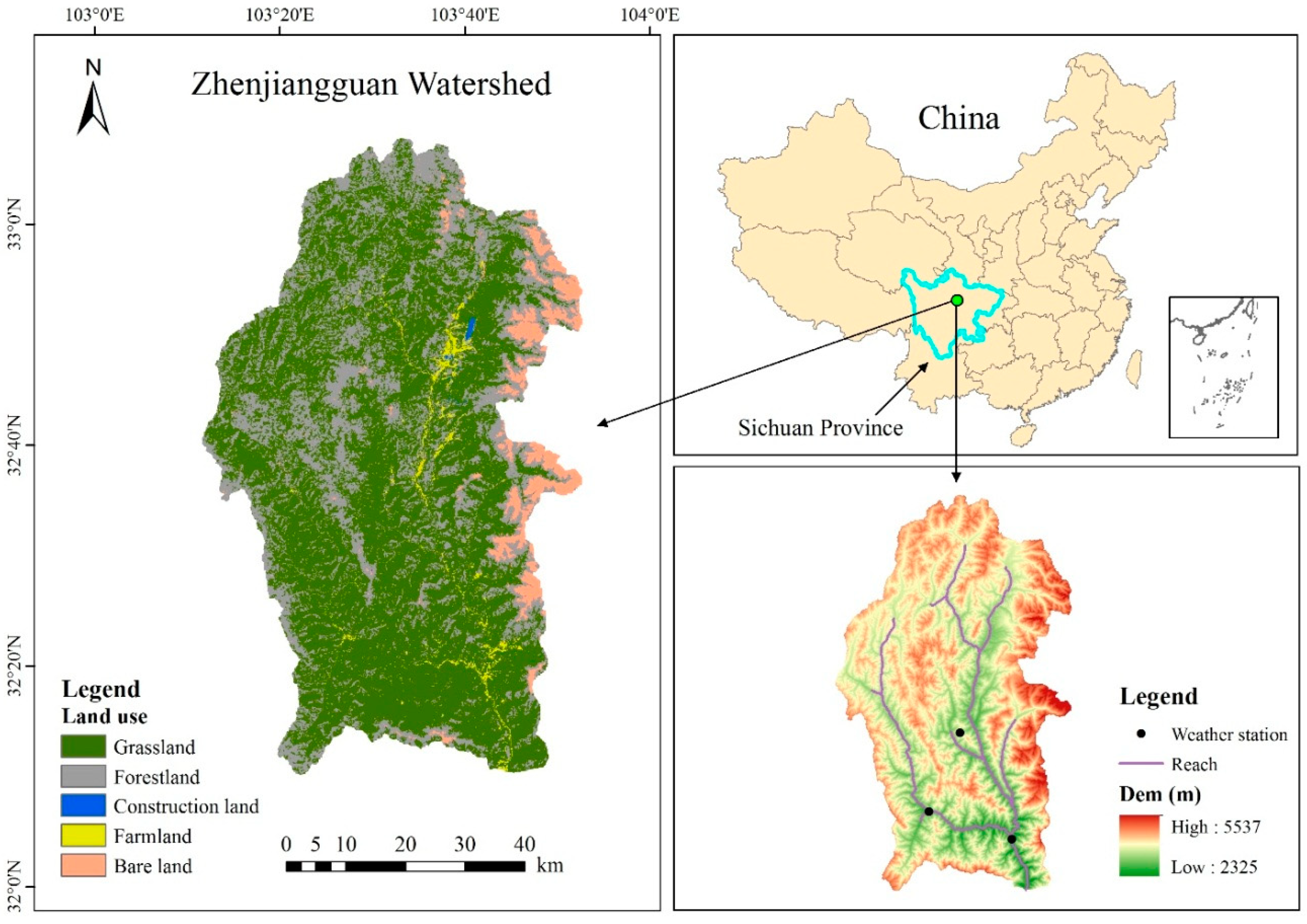

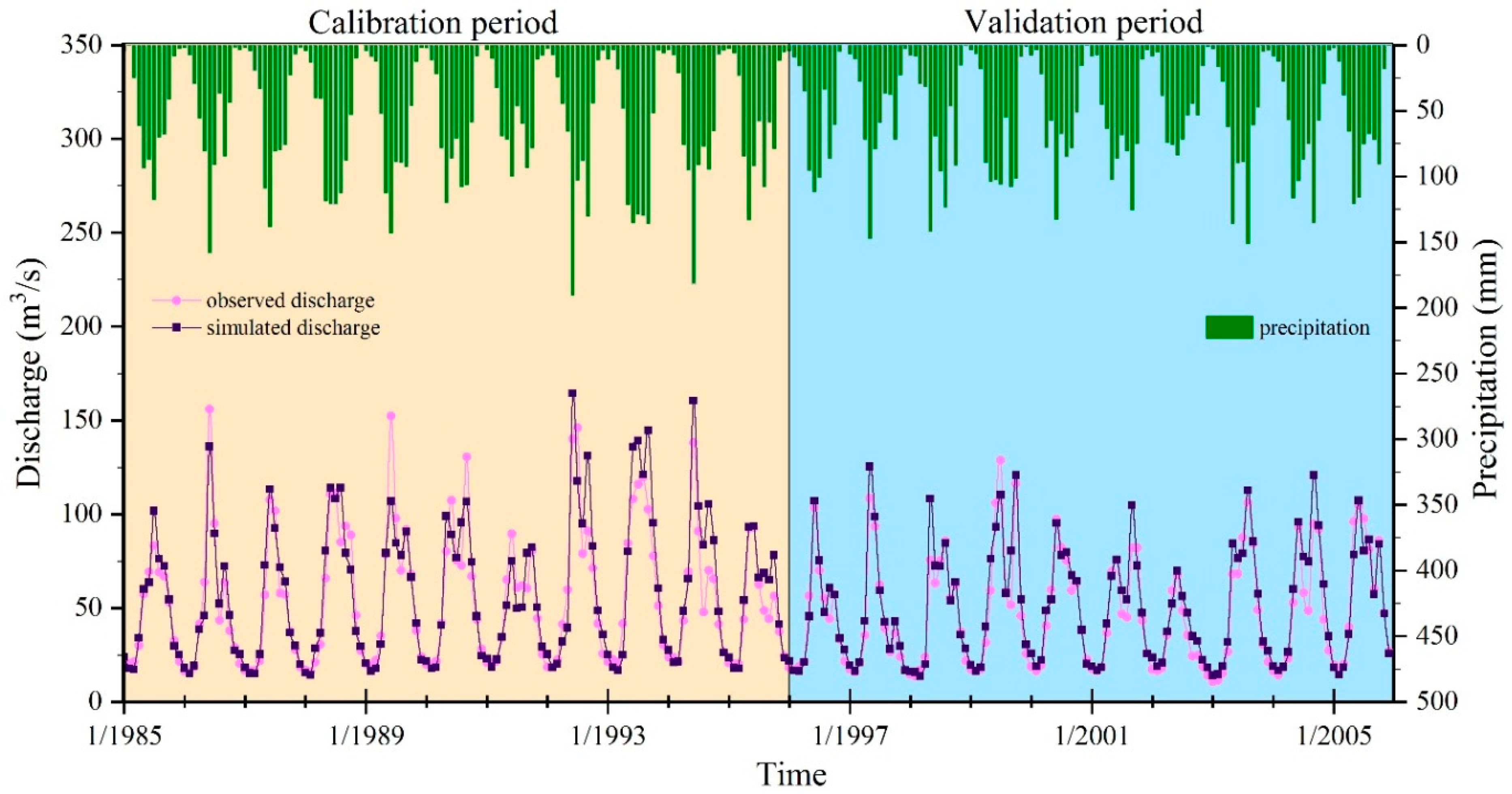
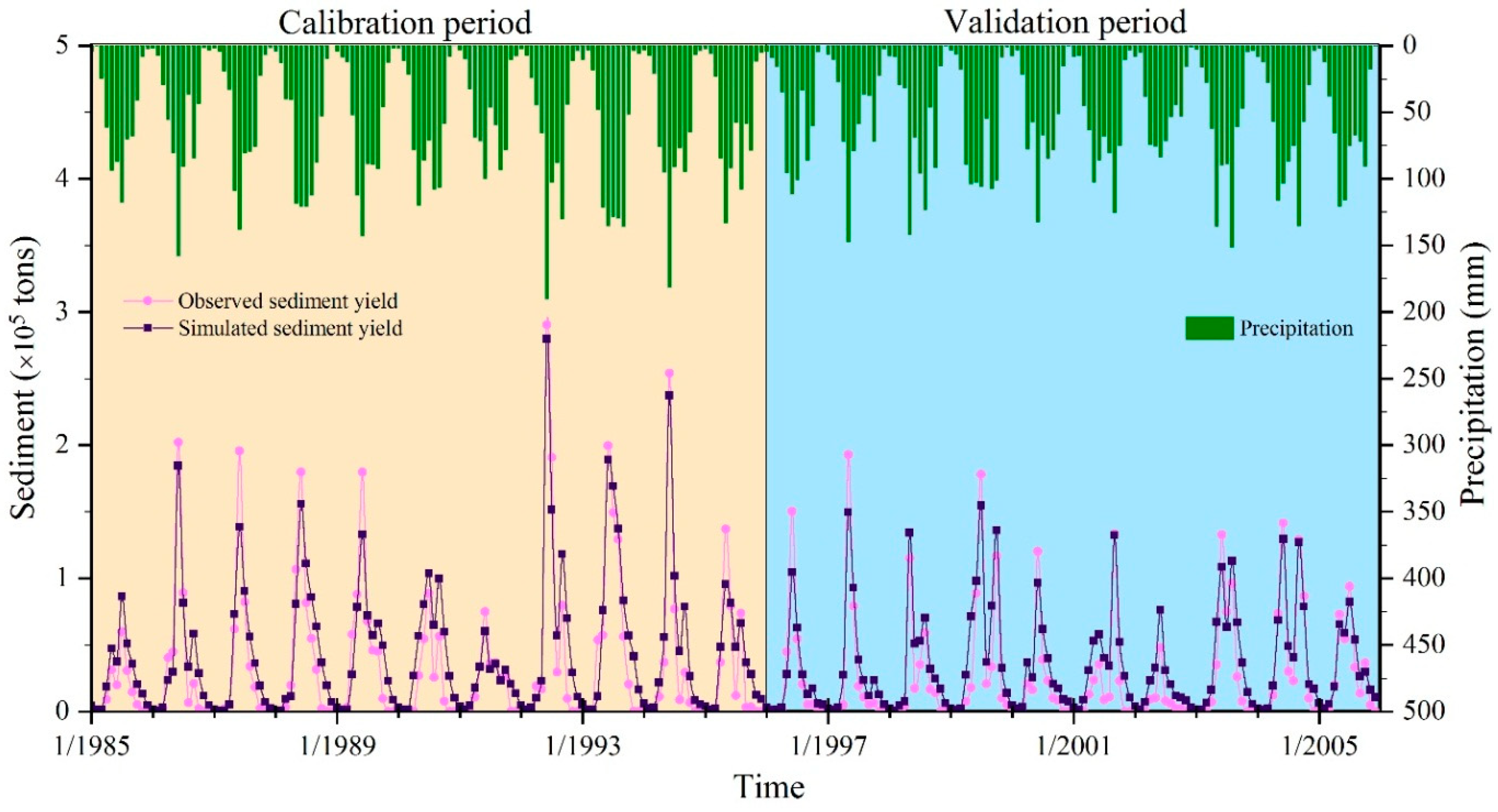
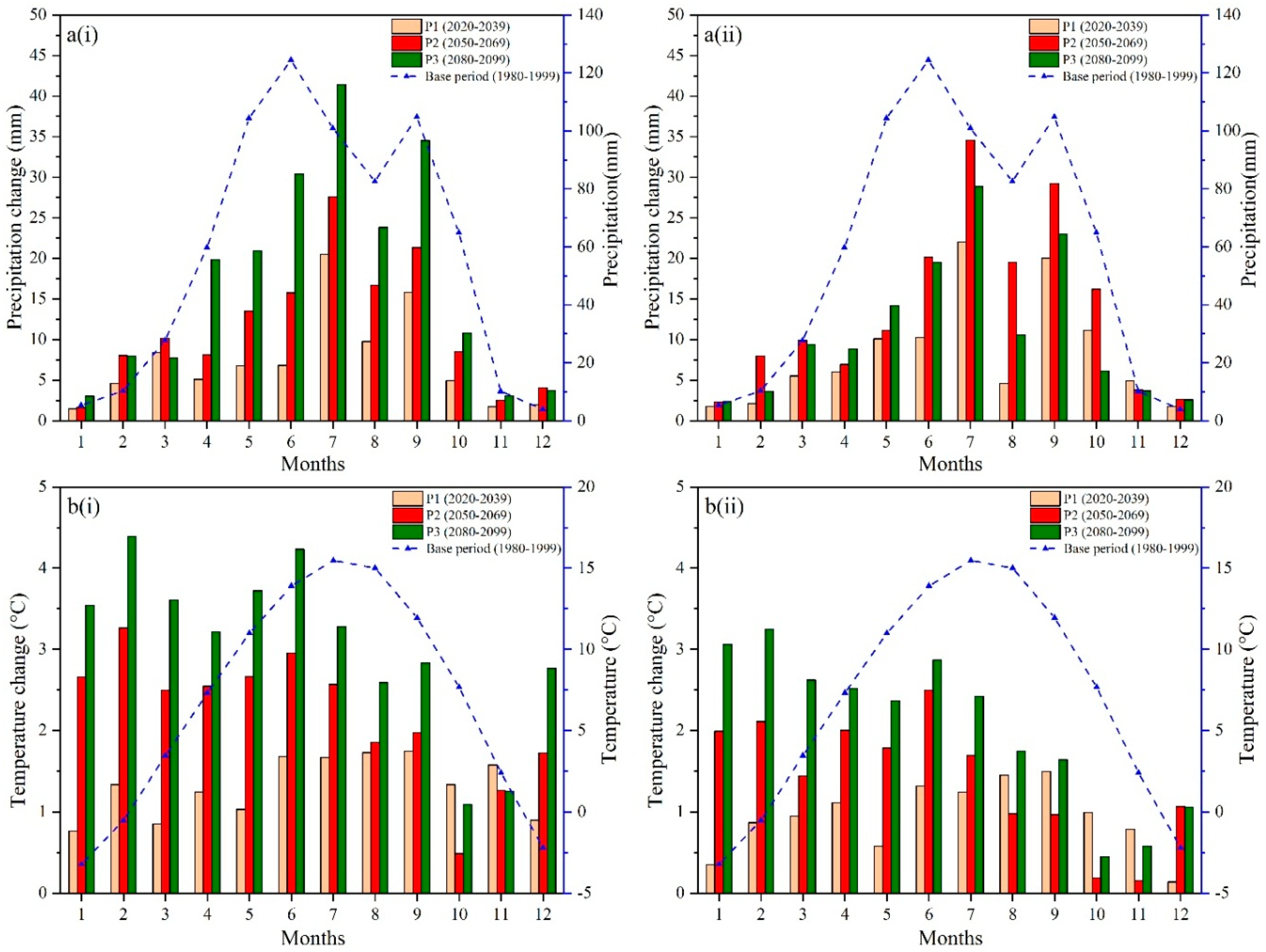
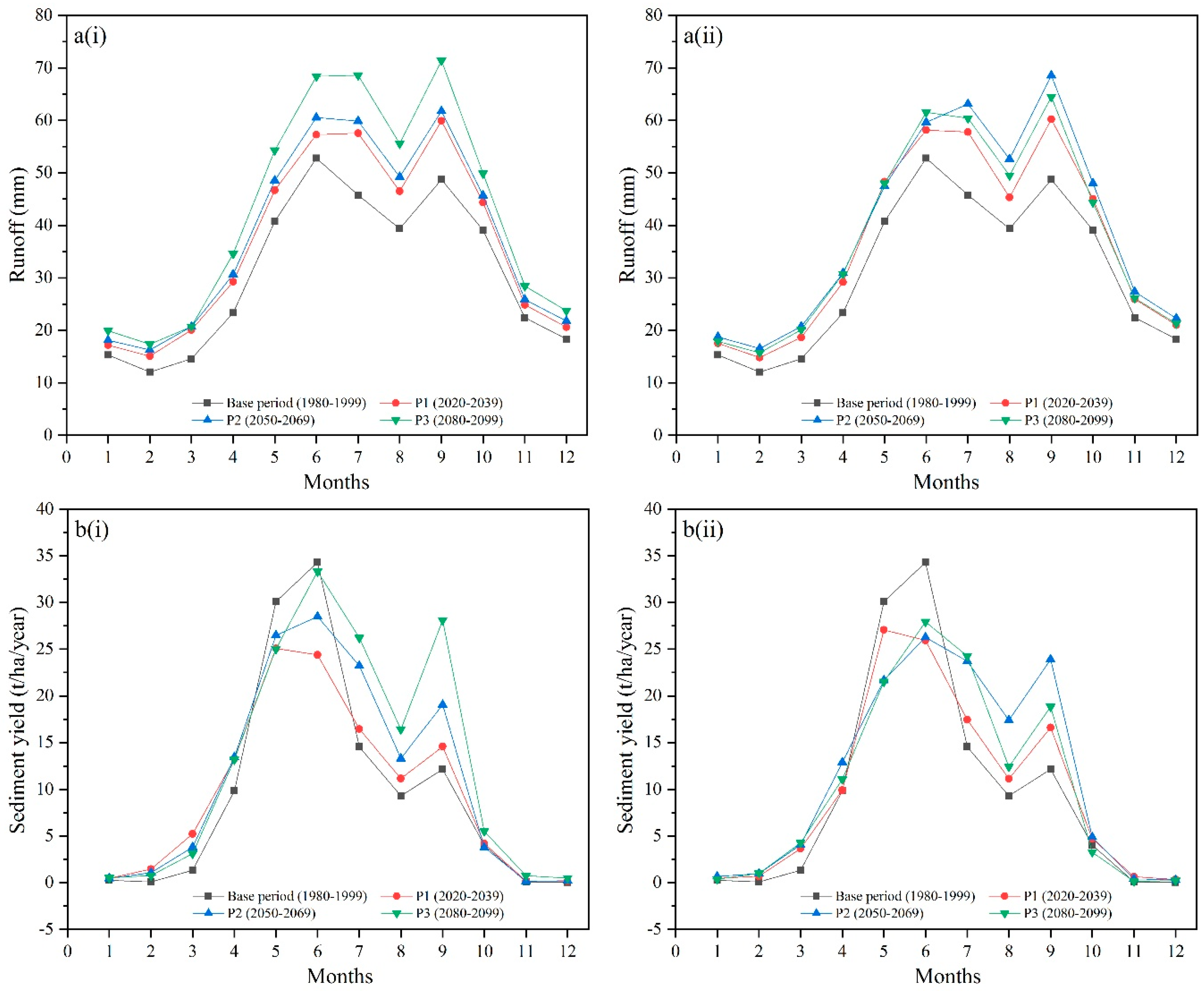
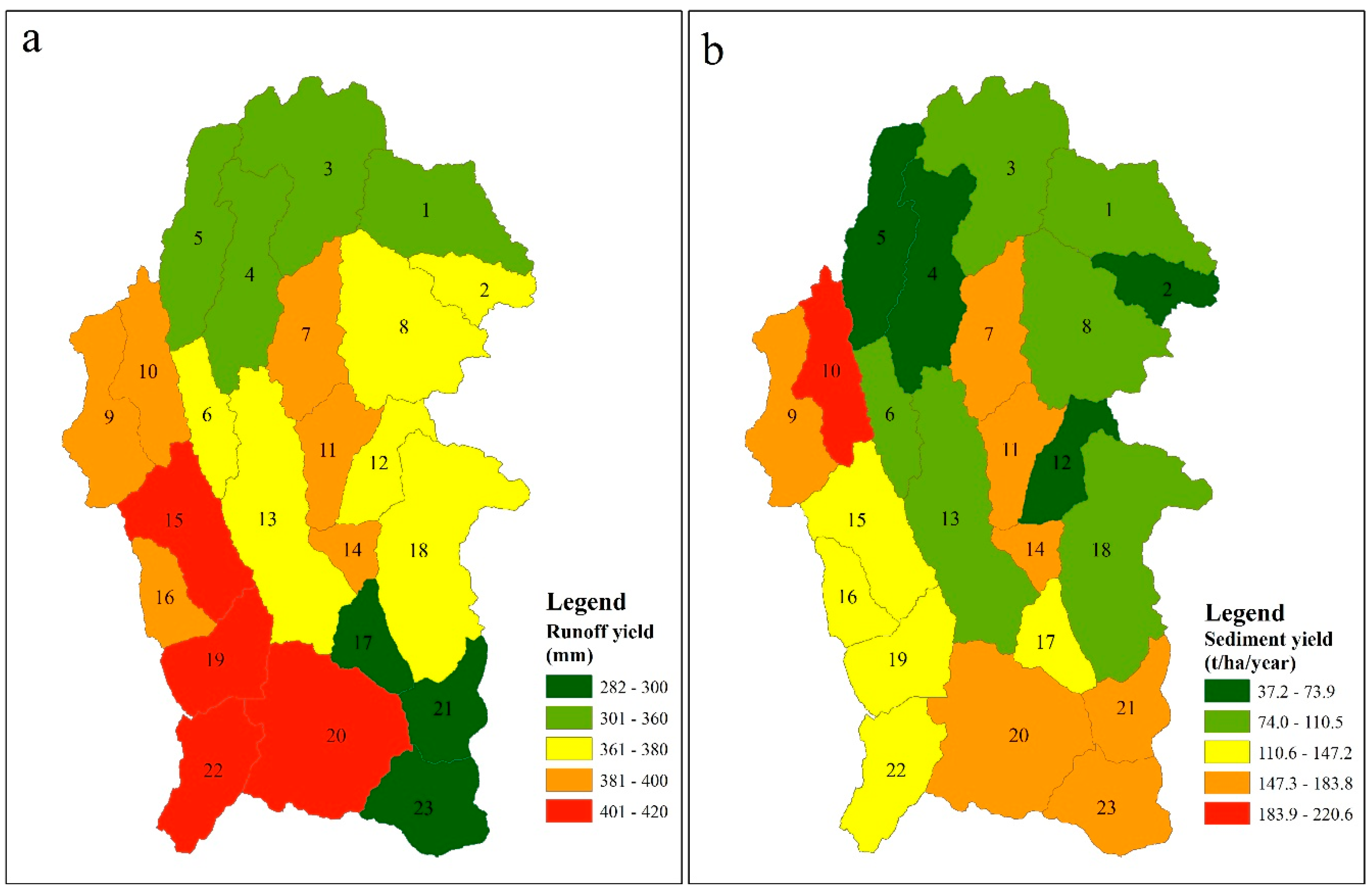
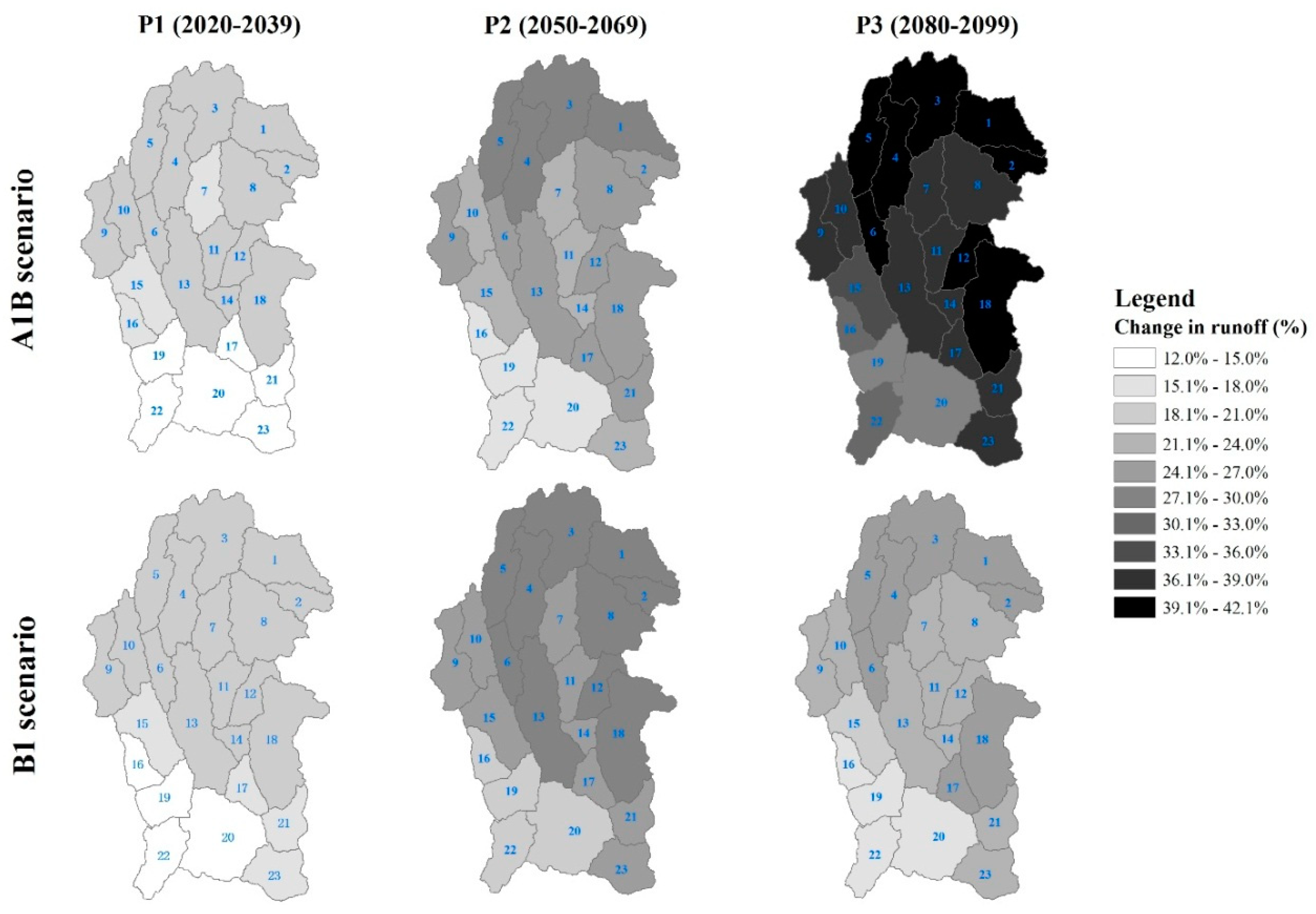
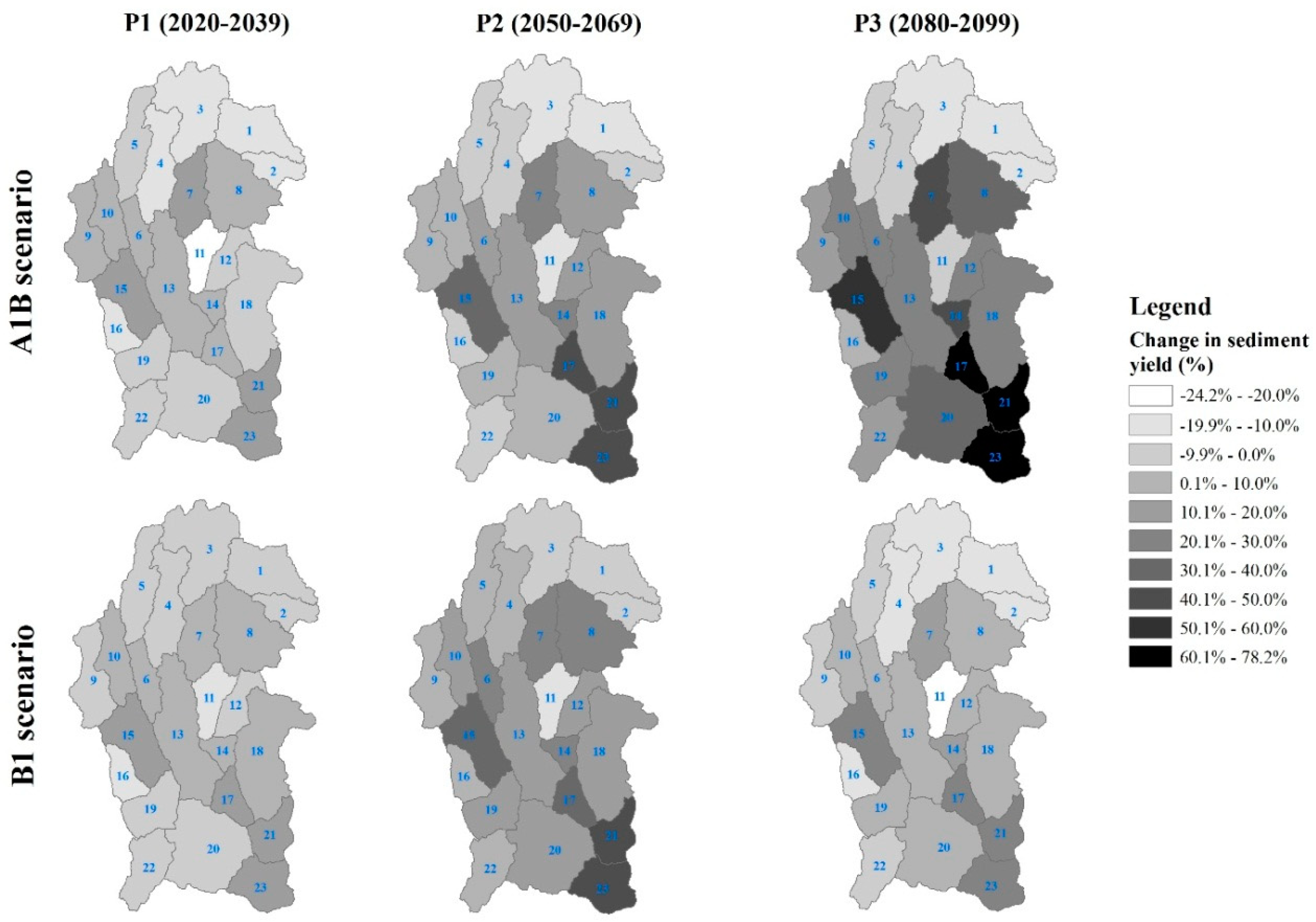
| Performance Rating | NSE | R2 | |PBIAS| (%) | |
|---|---|---|---|---|
| Discharge | Sediment | |||
| Very good | 0.75 < NSE ≤ 1.00 | 0.80 < R2 ≤ 1.00 | |PBIAS| < 10% | |PBIAS| < 15% |
| Good | 0.65 < NSE ≤ 0.75 | 0.70 < R2 ≤ 0.80 | 10% ≤ |PBIAS| < 15% | 15% ≤ |PBIAS| < 30% |
| Satisfactory | 0.50 < NSE ≤ 0.65 | 0.60 < R2 ≤ 0.70 | 15% ≤ |PBIAS| < 25% | 30% ≤ |PBIAS| < 55% |
| Unsatisfactory | NSE ≤ 0.50 | R2 ≤ 0.60 | |PBIAS| ≥ 25% | |PBIAS| ≥ 55% |
| Evaluation Index | Discharge | Sediment Yield | ||
|---|---|---|---|---|
| Calibration | Validation | Calibration | Validation | |
| PBIAS | 4.9% | 6.9% | 8.2% | 10.3% |
| R2 | 0.88 | 0.87 | 0.83 | 0.81 |
| NSE | 0.85 | 0.84 | 0.72 | 0.70 |
| Climate Model | A1B Scenario (mm) | B1 Scenario (mm) | ||||
|---|---|---|---|---|---|---|
| P1 | P2 | P3 | P1 | P2 | P3 | |
| T47 | 430 | 492 | 553 | 448 | 534 | 506 |
| HADCM3 | 442 | 457 | 524 | 425 | 454 | 431 |
| CCSM3 | 417 | 428 | 463 | 419 | 441 | 426 |
| Average | 430 (15%) | 459 (23%) | 513 (38%) | 431 (16%) | 476 (28%) | 454 (22%) |
| Climate Model | A1B Scenario (t/ha/year) | B1 Scenario (t/ha/year) | ||||
|---|---|---|---|---|---|---|
| P1 | P2 | P3 | P1 | P2 | P3 | |
| T47 | 126 | 156 | 178 | 128 | 159 | 138 |
| HADCM3 | 119 | 123 | 143 | 119 | 125 | 121 |
| CCSM3 | 117 | 122 | 141 | 118 | 124 | 118 |
| Average | 121 (4%) | 134 (15%) | 154 (32%) | 122 (5%) | 136 (17%) | 125 (8%) |
| Emission Scenario | Percentage Range (%) | |||
|---|---|---|---|---|
| P1 | P2 | P3 | ||
| Runoff yield | A1B | 14–20 | 15–27 | 29–42 |
| B1 | 14–21 | 18–30 | 15–26 | |
| Sediment yield | A1B | −21–13 | −20–53 | −15–78 |
| B1 | −20–17 | −15–46 | −24–31 | |
| Prior Interval (month) | RNDVI·Temperature | RNDVI·Precipitation | ||
|---|---|---|---|---|
| Grassland | Forestland | Grassland | Forestland | |
| 0 | 0.57 | 0.53 | 0.45 | 0.41 |
| 1 | 0.76 | 0.76 | 0.67 | 0.65 |
| 2 | 0.43 | 0.39 | 0.20 | 0.23 |
| 3 | 0.29 | 0.23 | −0.09 | −0.10 |
| 4 | 0.08 | 0.05 | −0.19 | −0.22 |
| Maximum | 0.76 | 0.76 | 0.67 | 0.65 |
| Adjusted R2 | Standard Error of Estimate (SEE) | Overall Significance (Sig.F) | Partial Regression Coefficients | Partial Regression Coefficient Significance (Sig.T) | ||||
|---|---|---|---|---|---|---|---|---|
| Constant | T | P | T | P | ||||
| Grassland | 0.67 | 0.04 | 1.7 × 10−4 | −0.32 | 0.066 | 0.001 | 0.003 | 0.032 |
| Forestland | 0.64 | 0.04 | 2.9 × 10−4 | −0.13 | 0.058 | 0.0008 | 0.004 | 0.044 |
| Runoff (%) | Sediment Yield (%) | |||||
|---|---|---|---|---|---|---|
| A1B | P1 | P2 | P3 | P1 | P2 | P3 |
| T47 | −7.3 | −9.1 | −9.6 | −7.1 | −9.0 | −8.7 |
| HADCM3 | −7.1 | −12.2 | −12.3 | −7.0 | −11.7 | −10.5 |
| CCSM3 | −9.3 | −14.4 | −12.2 | −9.0 | −13.4 | −11.1 |
| Average | −7.9 | −11.9 | −11.4 | −7.7 | −11.4 | −10.1 |
| B1 | P1 | P2 | P3 | P1 | P2 | P3 |
| T47 | −5.1 | −8.5 | −10.9 | −4.9 | −8.3 | −10.8 |
| HADCM3 | −6.6 | −10.5 | −14.0 | −6.4 | −10.0 | −13.8 |
| CCSM3 | −6.5 | −12.0 | −15.1 | −6.1 | −11.6 | −14.2 |
| Average | −6.1 | −10.3 | −13.4 | −5.8 | −10.0 | −12.9 |
© 2019 by the authors. Licensee MDPI, Basel, Switzerland. This article is an open access article distributed under the terms and conditions of the Creative Commons Attribution (CC BY) license (http://creativecommons.org/licenses/by/4.0/).
Share and Cite
Zhang, S.; Li, Z.; Lin, X.; Zhang, C. Assessment of Climate Change and Associated Vegetation Cover Change on Watershed-Scale Runoff and Sediment Yield. Water 2019, 11, 1373. https://doi.org/10.3390/w11071373
Zhang S, Li Z, Lin X, Zhang C. Assessment of Climate Change and Associated Vegetation Cover Change on Watershed-Scale Runoff and Sediment Yield. Water. 2019; 11(7):1373. https://doi.org/10.3390/w11071373
Chicago/Turabian StyleZhang, Shanghong, Zehao Li, Xiaonan Lin, and Cheng Zhang. 2019. "Assessment of Climate Change and Associated Vegetation Cover Change on Watershed-Scale Runoff and Sediment Yield" Water 11, no. 7: 1373. https://doi.org/10.3390/w11071373
APA StyleZhang, S., Li, Z., Lin, X., & Zhang, C. (2019). Assessment of Climate Change and Associated Vegetation Cover Change on Watershed-Scale Runoff and Sediment Yield. Water, 11(7), 1373. https://doi.org/10.3390/w11071373





